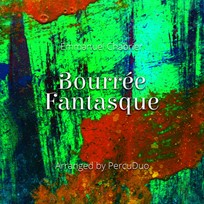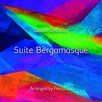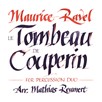
Bourrée Fantasque
Composer: Emmanuel Chabrier
Instrument: Percussion Duo
Level: Intermediate/Advanced
Published: 2018
Price: €28.00
Item details
-
Description +
-
Arranged by PercuDuo
Duration: 10 min.
Damien PETITJEAN, soloist of Paris National Opera Orchestra and Philippe LIMOGE, percussion professor in Montpellier, met when they were teenagers in a french summer academy. Few years later, they were both students with Mr Jacques Delécluse in Paris Conservatoire National Supérieur de Musique. The story of PercuDuo begun, a story of friendship through the passion of music.
« Acousticks » is the first CD of PercuDuo. It is also a long term project based on transcriptions of piano pieces for keyboards percussion instruments, vibraphone and marimba. These instruments are complementary and their combination gives a huge harmonical variety. Then the challenge was to always be as close as possible with the composer's idea of the sound, despite of the transcription.
Damien Petitjean and Philippe Limoge worked first to find the most appropriate repertoire. After trying many compositions, they found a well-balanced program covering a large period of music. From Jean Sebastien Bach's « Suite Française » to George Gerswhin's « Rapsody in Blue », « Acousticks » also explores great piano composer's like Felix Mendelssohn. It keeps a large part for French music through Maurice Ravel (« Pavane pour une Infante Défunte »), Emmanuel Chabrier (« Bourrée Fantasque ») and Claude Debussy (« Suite Bergamasque »).
Emmanuel Chabrier, french composer of the second part of the 19th century, was born in Auvergne, region located in the center of France. Admirer of Debussy, Ravel, Strauss, he was also close friend of the painters Claude Monet and Édouard Manet, and collected Impressionist paintings before Impressionism became fashionable. He composed « Bourrée Fantasque » around april 1891, at the end of his life, following a visit to his native Auvergne, as the bourrée is a traditionnal dance from this region. Here, the piano is treated almost like an orchestra, discovering innovations in pianistic technique introduced by Ravel in Gaspard de la nuit or Debussy in his last Études.
The precision of the notation in each bar, dynamics from ppp to tutta forza, accents, pedal indications, bear witness to his wish to obtain an exceptional tonal variety and richness. In 2/4 time, the piece opens with the repeated notes of the main theme (Très animé et avec beaucoup d’entrain) hammered out in the middle register of the piano, and put through its paces. The middle section changes mood with a freely-modulating caressing melody (molto espressivo) before the original theme returns pp, worked in combination with the second theme, until the main bourrée theme rampages from top to bottom of the keyboard subjected to increasing elaboration and bravura treatment.
« Chabrier was the forerunner of modern French composers through the boldness of his writing technique, use of certain chord progressions, and use of modal atmosphere and ancient modes - which is never artificial or imitative, but a natural means of poetic expression. » (Charles Koechlin)
-
-
Instrumentation +
-
Vibraphone and Marimba
-
-
About the composer +
-
Alexis Emmanuel Chabrier (January 18, 1841 – September 13, 1894) was a French Romantic composer and pianist. Although known primarily for two of his orchestral works, España and Joyeuse marche, he left an important corpus of operas (including L'étoile), songs, and piano music. He was admired by composers as diverse as Debussy, Ravel, Richard Strauss, Satie, Schmitt, Stravinsky, and the group of composers known as Les six. Stravinsky alluded to España in his ballet Petrushka; Gustav Mahler called España "the beginnings of modern music" and alluded to the "Dance Villageoise" in the Rondo Burleske movement of his Ninth Symphony. Ravel wrote that the opening bars of Le roi malgré lui changed the course of harmony in France, Poulenc wrote a biography of the composer, and Richard Strauss conducted the first staged performance of Chabrier's incomplete opera Briséïs.
Chabrier was also associated with some of the leading writers and painters of his time. He was especially friendly with the painters Claude Monet and Édouard Manet, and collected Impressionist paintings before Impressionism became fashionable. A number of such paintings from his personal collection are now housed in some of the world's leading art museums.
-
-
Reviews +
-
Review (Percussive Notes, June 2020)
This arrangement of “Bourrée Fantasque” distributes the original piano work to 4-octave vibraphone and 5-octave marimba. The arrangement clocks in at roughly 6½ minutes and would be appropriate for an undergraduate senior or graduate recital.
Both parts have equal levels of demand, with both players having moments in the spotlight, though the vibraphone holds the melody a majority of the time simply due to the range the instrument covers. While most of the range of the 4-octave vibraphone is used in the arrangement, these sections could be transposed by an octave (preferably in both marimba and vibraphone to preserve the relationship of the notes) to make the piece fit vibraphones with smaller ranges.
Technical demands in the work will require performers with well-developed four-mallet technique in both parts. Musically, the piece is also quite demanding due to the nature of the original work. The arrangers were meticulous with the original dynamics and articulations, making it a challenge for performers to accurately achieve the colors Chabrier was looking for in the original work. That being said, the arrangers have made some adjustments to make the piece more idiomatic to percussion keyboard instruments.
The character of the work is well preserved in this arrangement, and while the piece will no doubt be a challenge for those willing to program this arrangement, the payoff will be a beautiful piece in the French Impressionist style that will please both performers and audience members.
—Brian Nozny
-
-
Credits +
-
Front Cover layout: Gaia Gomes
Engraving: PercuDuo
Printed in Copenhagen,
Denmark www.editionsvitzer.com
-





